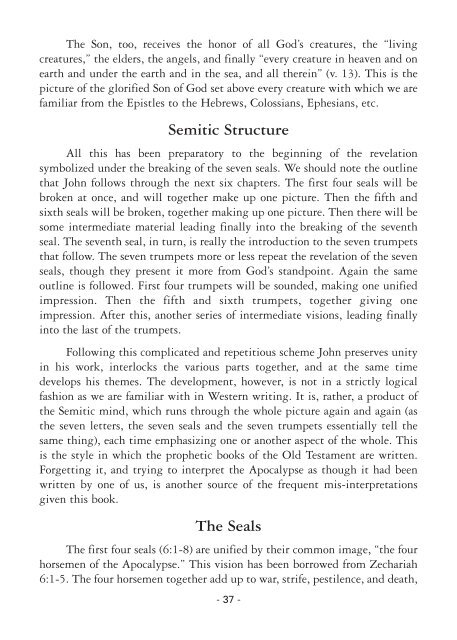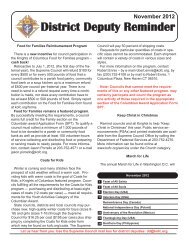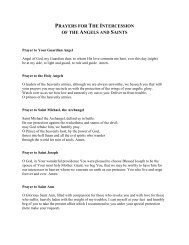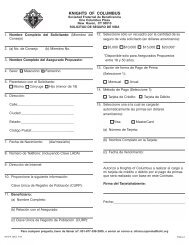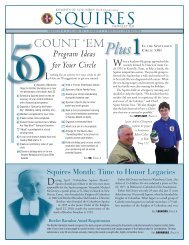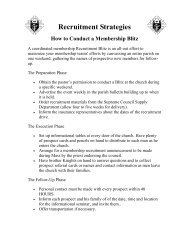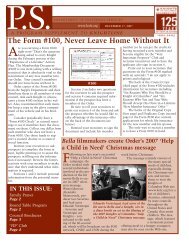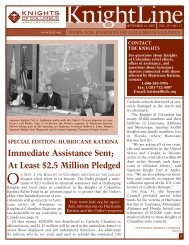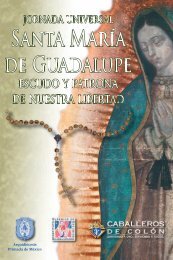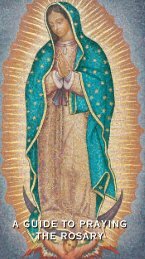Revelation: - Knights of Columbus, Supreme Council
Revelation: - Knights of Columbus, Supreme Council
Revelation: - Knights of Columbus, Supreme Council
Create successful ePaper yourself
Turn your PDF publications into a flip-book with our unique Google optimized e-Paper software.
The Son, too, receives the honor <strong>of</strong> all God’s creatures, the “living<br />
creatures,” the elders, the angels, and finally “every creature in heaven and on<br />
earth and under the earth and in the sea, and all therein” (v. 13). This is the<br />
pic ture <strong>of</strong> the glorified Son <strong>of</strong> God set above every creature with which we are<br />
familiar from the Epistles to the Hebrews, Colossians, Ephesians, etc.<br />
Semitic Structure<br />
All this has been preparatory to the beginning <strong>of</strong> the revelation<br />
symbolized under the breaking <strong>of</strong> the seven seals. We should note the outline<br />
that John follows through the next six chapters. The first four seals will be<br />
broken at once, and will together make up one picture. Then the fifth and<br />
sixth seals will be broken, together making up one picture. Then there will be<br />
some intermediate material leading final ly into the breaking <strong>of</strong> the seventh<br />
seal. The seventh seal, in turn, is really the introduction to the seven trumpets<br />
that follow. The seven trumpets more or less repeat the revelation <strong>of</strong> the seven<br />
seals, though they present it more from God’s standpoint. Again the same<br />
outline is followed. First four trumpets will be sounded, making one unified<br />
impression. Then the fifth and sixth trumpets, together giving one<br />
impression. After this, another series <strong>of</strong> intermediate visions, lead ing finally<br />
into the last <strong>of</strong> the trumpets.<br />
Following this complicated and repetitious scheme John preserves unity<br />
in his work, interlocks the various parts together, and at the same time<br />
develops his themes. The development, however, is not in a strictly logical<br />
fashion as we are familiar with in Western writing. It is, rather, a product <strong>of</strong><br />
the Semitic mind, which runs through the whole picture again and again (as<br />
the seven letters, the seven seals and the seven trumpets essentially tell the<br />
same thing), each time emphasizing one or another aspect <strong>of</strong> the whole. This<br />
is the style in which the prophetic books <strong>of</strong> the Old Testament are written.<br />
Forgetting it, and trying to interpret the Apocalypse as though it had been<br />
written by one <strong>of</strong> us, is another source <strong>of</strong> the frequent mis-interpretations<br />
given this book.<br />
The Seals<br />
The first four seals (6:1-8) are unified by their common image, “the four<br />
horsemen <strong>of</strong> the Apocalypse.” This vision has been borrowed from Zechariah<br />
6:1-5. The four horsemen together add up to war, strife, pestilence, and death,<br />
- 37 -


